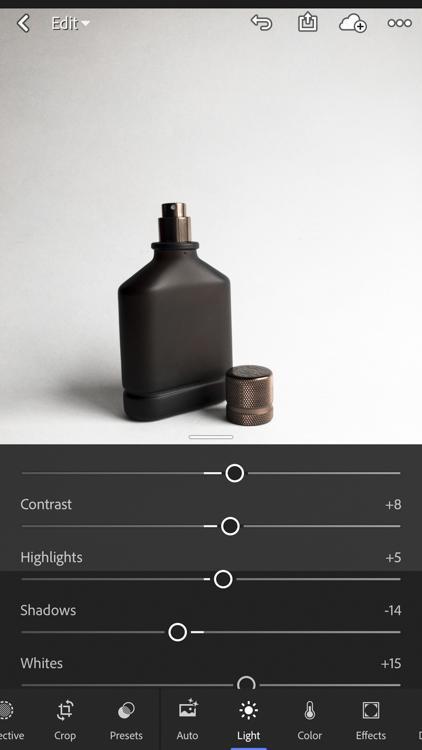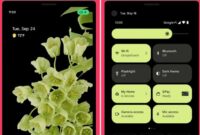5. Use your camera’s manual settings
The beauty of using a professional camera to shoot is that you can control every single aspect of the photo through various settings. But before you even get started with settings, you need to get your tripod set up. Using a tripod is essential to getting the most out of your camera settings. For those who don’t have a tripod, a stack of books will do.
A tripod is necessary because it provides stability, minimizing tiny movements that can ruin a great photo. I’d recommend you make sure your tripod is in line with the product you’re shooting, as this makes it easier when tweaking the settings as you take photos.
To achieve the best results, I’d recommend always shooting in manual mode. Mastering manual mode lets you adapt to your environment, whether it’s outdoors or an indoor studio, and shoot top-notch photos in a variety of lighting conditions.
Shooting in manual mode gives you the power to control all settings, without worrying about the wrong automatic setting being used, like the flash. The main settings you should master to make the most of natural lighting are:
- Aperture
- ISO
- White balance
- Shutter speed
Aperture
First, we’ll look at aperture. I’d recommend you use a higher f-stop because it helps keep every detail in focus. I prefer to shoot between f/8 and f/14 as this keeps the entire product in focus without losing too much light.
If you want to make sure the entire product is in focus, use a setting above f/12. Some cameras may not go that high, so just use the highest setting available. Ultimately, the higher the aperture the clearer the final photo will be.
ISO
Next, let’s get to grips with ISO. The ISO setting manages the camera’s reaction to light. The lower your ISO, the less sensitive the camera is to light and the higher the image quality. But when the ISO setting is too high, images start to look grainy or pixelated. When shooting in a dark environment, a higher ISO is needed, but the goal is to find a good balance between improving the lighting and the image quality.
Once you get the right ISO setting according to your surroundings, you’ll achieve beautifully crisp product photos. My studio has excellent natural lighting, so I usually stick to an ISO between 300-500 depending on the weather outside. On a particularly cloudy day, I turn my ISO up high to warm the sensors up and then adjust it until the image is nice and clean.
White balance
Choosing the right white balance will mean your camera accurately adjusts according to the color of your product in conjunction with the light. For beginners, you probably want to use the automatic white balance setting, so the camera automatically chooses the right setting according to the lighting.
Once you start getting a bit more confident with your camera settings, I’d suggest you manually select the white balance setting that most accurately reflects what you see. The goal is to get as close a match between what you see in your camera viewfinder and your eyes. Despite being a huge amplifier of natural lighting, it does take some getting used to and adjustments.
A sudden increase in sunlight or even particularly harsh sunlight can leave your images being overexposed. An overexposed image is tough to correct in post-photography editing—especially if you’re using a free photo editing software—as the detail is not crisp enough due to the harsh lighting. Follow the advice above about harnessing natural light , and you’ll have no problem working around it.
Shutter speed
When you’ve set the aperture, ISO and white balance, you can finally set your shutter speed. The shutter speed will decide how long the shutter is open when taking photos. Longer shutter speeds help the camera pick up more light, which makes for a beautifully crisp photo.
My top tip for getting the most of your shutter speed, and all the camera settings, is to use a tripod. Keeping the camera stable allows all the settings to work together cohesively, leaving the camera’s internal light meter to do its work, resulting in picture perfect product photos.
Manual settings for a smartphone camera
There’s no denying that using a professional camera is the ideal solution when taking product photos. But, don’t let that hold you back. Smartphone technology is advancing year over year, and most of them have excellent built-in cameras. At the very least you can take some good-quality photos, and leave the rest up to editing.
A few key tips when shooting product photos with your smartphone:
- Avoid the zoom feature as this significantly reduces the quality of the image
- Avoid blurry photos by investing in a tripod for your smartphone
- Avoid the selfie camera as the front camera is not as good at the back camera
- Avoid using the flash as this will overexpose your photo and distort the colors
- Avoid distracting or dark background, always shoot against a plain white background
- Avoid over editing as this reduces the quality of the photo, minor adjustments only
Numerous apps can help you get results similar to a DSLR camera. The one I often recommend is Lightroom CC. Within this app, you can control settings such as file format, choosing between JPEG and DNG. DNG provides more information about the image and produce a better quality photo. The downside of using DNG is that it takes up more storage space on your device.
Other factors you can adjust are aspect ratio, timer, grids, and levels, as well as highlight clipping, which shows you precisely what is overexposed in the image. Once you’ve taken your images, you can adjust color, exposure, tone, and contrast within Lightroom CC.
I recommend that you downloaded Lightroom CC on your desktop so that you can sync your photos between your desktop and mobile app. I prefer editing photos on the desktop version as I have a bigger screen and can get a closer look at what needs to be fixed.
6. Shoot your product photos
Now that you’ve got everything set up, it’s time to start taking photos. Undoubtedly you’ll have to adjust things throughout the shoot, but practice makes perfect. Have fun and embrace your creativity. Shoot lots of photos in a variety of different angles, making a note of the settings you used and what they produced.
Take time between different angles to review the images to see if you need to adjust any settings. If you have time, I’d suggest you upload them to your laptop or computer throughout the shoot so you can get up close and personal. Once you’ve chosen the best photos, it’s time to edit.









